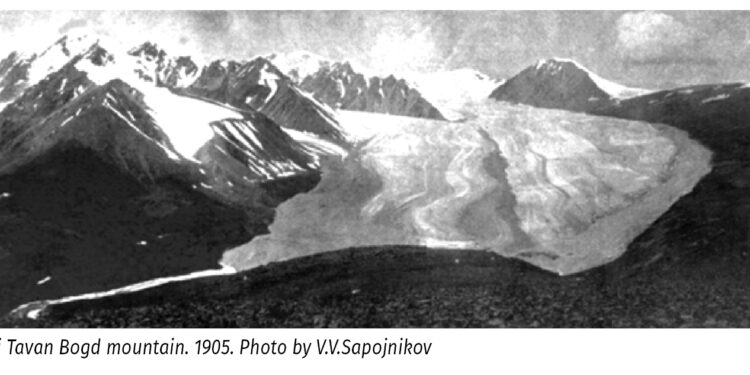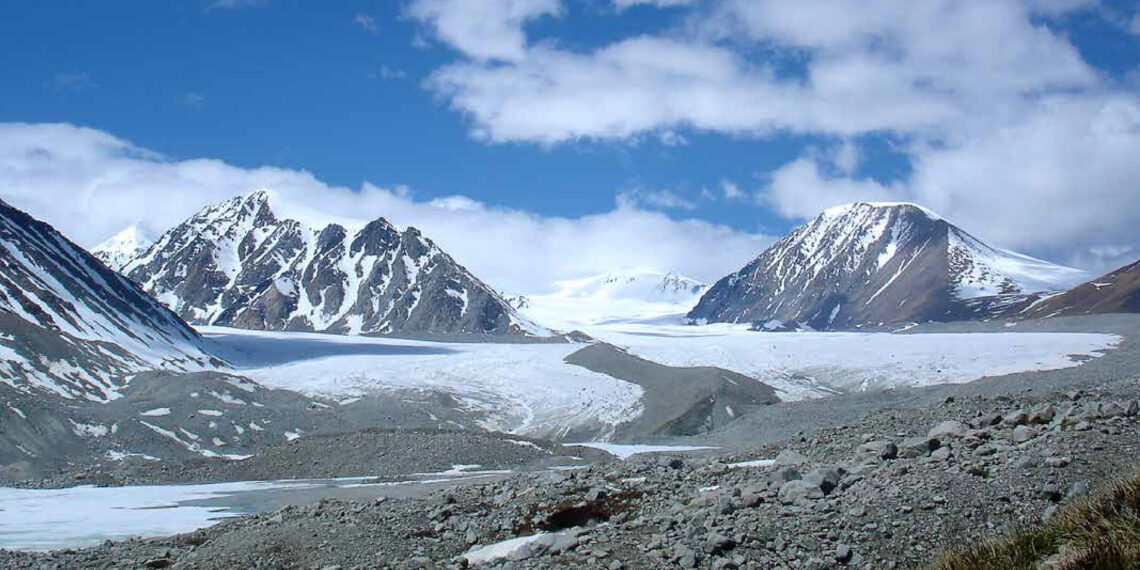According to the Sixth Assessment Report of the Intergovernmental Panel on Climate Change (IPCC), the global average temperature has increased by 1.1°C above the pre-industrial level (the global average temperature between 1850 and 1900) over the last decade. Moreover, the report has also shown that global warming is indeed accelerating based on concrete scientific evidence. The concentration of carbon dioxide (CO2), a key greenhouse gas (GHG) that drives climate change, in the atmosphere was higher than at any time in the last 2 million years. The world’s firns and glaciers are retreating unprecedentedly in the last 2000 years and the Arctic sea ice area is shrinking more rapidly than at any time in at least the past 1000 years.
Since the 1940s, the time when regular meteorological observations and measurements began in Mongolia, the average temperature increased by 2.4°C and the average precipitation rate declined by 6.4 percent in the past 80 years. Especially, in the less populated Gobi region, the CO2 concentrations have increased by 16.5 percent in the last 20 years.
The following are examples of the real impacts behind those figures on the development of our country and livelihoods. Between July to August of 2021, almost all continents of the world suffered from wildfires caused by heatwaves and droughts. At that time, the smoke from Siberia wildfires reached most regions of Mongolia. Not only that, flooding occurred on four continents across 385 locations in that July and over 920 people died because of floods and landslides. Meanwhile, the speed of hurricanes and storms that swept several states in the US reached over 60 meters per second in August of 2021. Over 60 people died as a result of Hurricane Ida which hit eight states in the US. For Mongolians, who live on the open steppe and build lightweight houses like the Mongolian yurt, it’s difficult to imagine such damaging and intense hurricanes. In fact, there is a chance of such hurricanes extending outwards and reaching our country.
Regarding Mongolia, the country had abundant rainfall and as a result benefited from lush pasture and hay, as well as all the conditions for a rich harvest in place in 2021. Unfortunately, several regions were flooded and the death toll almost reached 40 including eight children. The above-mentioned IPCC report, other research and data show that the current situation is expected to get even worse in the future. Humanity did detect that global warming had started at the end of the 18th century. To illustrate, climate studies have begun to be regarded as a field of science from the late 1940s and the warming effect of CO2 has become a point of discussion since 2009. It could be said that we wasted our time thinking that global warming might be a natural cycle, the earth going through cold and warm periods. But, we weren’t far behind science. In fact, the very first carbon dioxide observatory was opened at the end of the 1950s. Also, the project called International Geophysical Year accelerated research on climate and laid the groundwork for satellite launch, digital signal processing, and the introduction of processing technologies in research, analysis and practical use of meteorological data.

In 1961, under Resolution No.1721 adopted by the UN General Assembly, World Meteorological Organization (WMO) established the World Weather watch with an aim to conduct comprehensive studies on the earth’s atmosphere and to provide observations of the current state of the earth and its climate. Later in 1974, the Sixth Special session of the UN General Assembly called on WMO to undertake a special study on climate change. Thereby, the report of the Executive Committee Panel of Experts on Climate Change established by WMO was released in 1977 and concluded that speculation on “the global cooling” is incorrect and on the contrary confirmed the expectation of global warming.
The first World Climate Conference of 1979 laid the foundation for the World Climate Program. After the session in 1987, upon the recommendations of the World Meteorological Congress, its
Secretary-General Professor G.O.P. Obasi and the Executive Director of the United Nations Environment Programme paved the way for the establishment of the Intergovernmental Panel on Climate Change (IPCC) which was established in 1988. The IPCC takes on the high responsibility of making assessments of the global and regional climate situations, providing a scientific basis for measures necessary in mitigating the scenarios disastrous to humankind and shedding light on the adaptation measures to reduce the risks and impacts of climate change. The organization released its first climate assessment report in 1990 and its sixth report this year. Moreover, the fact that IPCC was awarded the Nobel Peace Prize in 2007 is a clear indication that the rest of the world supports the organization and values its contributions.
In 1990, the statement from the second World Climate Conference highlighted the importance of establishing a Global Climate Observing System (GCOS) and finalized the plan for the creation of independent observation systems Global Terrestrial Observing System and Global Ocean Observing System in 1995. Their successful operations and work are playing the main role in observing and assessing climate change.
The very first international legally binding document that allows the implementation of the United Nations Framework Convention on Climate Change (UNCCC) was the Kyoto Protocol which was signed in March 1998 and came into force after seven years on February 16, 2005. The Kyoto Protocol commits industrialized countries to reduce their GHG emissions by five percent below their 1990s level. However, due to the so-called “economic impact”, countries didn’t join or joined the Protocol too close to the deadline. Hence, we didn’t achieve the expected results of the Protocol which led to an extension of its deadline to 2020. The Paris Agreement that followed the Kyoto Protocol didn’t classify countries based on their level of development and didn’t impose a strict obligation on countries, but set a goal to limit global warming well below 2°C, preferably to 1.5°C. In addition to that, the Agreement stipulates that countries must mobilize 100 billion USD to assist the least developed countries and small island countries that are vulnerable to climate change by 2020. This article is difficult to achieve but it is legally binding. Nonetheless, 196 countries that attended the UN Climate Change Conference held in Paris agreed to adopt the Paris Agreement on the last day of the conference, on February 12, 2015. What is more, the Agreement came into force within a year on November 4, 2016. The pledges to reduce GHG emissions of countries signatory to the Paris Agreement are below the targets to achieve the goal to limit global warming to not only 1.5°C but even 2°C. The delayed 26th Climate Change Conference was held in Glasgow on November 1-12, 2022 and encouraged countries to set higher National Determined Contribution (NDC) targets.
It’s important to note that Mongolia has been active in approving and adopting laws, protocols and agreements necessary to carry out the goals of the above conventions on climate change; joining discussions for officializing such documents and putting all its efforts into increasing the effectiveness of implementation measures. Mongolia is fulfilling its obligations as a member of the international community. Furthermore, Mongolia’s involvement opens a possibility of finding the right and most optimal solutions for challenges faced by our country which is considered as one of the vulnerable nations to climate change due to the fact our lifestyle and tradition is fully dependent on nature and weather.
In terms of challenges, most of them are directly correlated to human-induced factors and some are indirectly or not at all correlated to human activity. According to the assessment of experts, in the last 20 years, low precipitation years continued in the Mongolian soil, warming temperatures enhanced evaporation and the climate has been getting drier. Simultaneously, Mongolia is highly likely to keep experiencing lower rainfall rates in the summer and higher snowfall rates in the winter which might put pressure on Mongolia’s main source of food and income, animal husbandry and agriculture.
In general, scientists explain that as well as warming temperatures and droughts, the frequency and intensity of extreme weather such as sudden cold weather, heavy snowfall and rainfall, periodic strong winds, storms and wildfires caused by heat waves, are all attributed to climate change.
Mongolia has updated its Nationally Determined Contribution (NDC), a contribution to fulfilling the obligations under the Paris Agreement. The updated NDC includes revised goals of NDC that were submitted to UNFCCC before the Paris Agreement went into effect in 2015; higher ambition to reduce greenhouse gas emissions, actions to limit climate-related impacts and risks, and detailed measures to adapt to the impacts of climate change and new implementation roadmap. The Ministry of Environment and Tourism of Mongolia is at the stage of carrying out its plan to implement the above NDC measures. To meet the goals of NDC and efficiently implement various measures for reducing GHG emissions and adapting to climate change, the Government of Mongolia is utilizing all levers of international cooperation by cooperating with
international development organizations, international financial institutions, intergovernmental and non-governemntal organizations, neighboring countries and other partnering countries.

It was estimated that Mongolia could reduce its GHG emissions by 22.7 percent or by 16.9 million tons of CO2 equivalent by 2030 by implementing measures to reduce the GHG emissions in major emitting sectors. The energy, agriculture, manufacturing and waste sectors represent 66.7, 31.3, 1.4 and 0.6 percent of total GHG emissions correspondingly. Within the framework of current and future development models, Mongolia is projected to reduce its GHG emissions by 7.2 percent by 2020, 12.3 percent by 2025 and 22.7 percent by 2030, but at this moment, we’re not making consistent progress because of certain reasons.
Mongolia is developing a more detailed special plan that incorporates necessary technologies and funds to carry out concrete measures in adapting to potential risks and reducing the impacts of climate change on the economic areas that are vulnerable to climate change and the socially important sectors. The new sources of energy like green hydrogen, reduction of air pollution as well as GHG and movement to plant trees have many benefits including restoring vascular plants which could slow down water evaporation and desertification caused by climate change.
Conclusion: Regardless of the level of development, climate change is affecting the livelihood of citizens all over the world, economies, and social development. On top of that, the current COVID-19 pandemic has become a global threat to humankind that cannot be prevented by vaccines. Having said that, the world can overcome the above challenges if all countries can come to an agreement to turn those challenges into opportunities without turning them into argument points like ideology, political debate or economic dispute.






